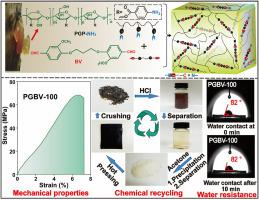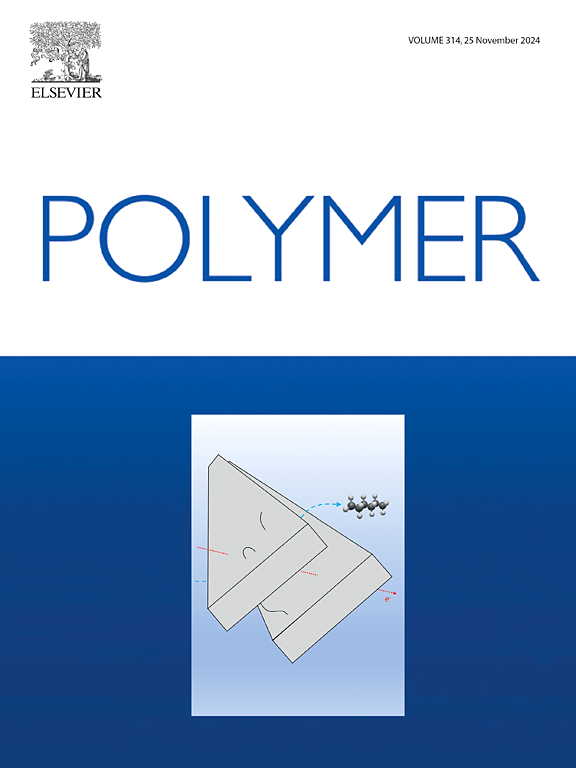桃胶基聚酰亚胺网络具有防水、高强度和可回收的性能
IF 4.1
2区 化学
Q2 POLYMER SCIENCE
引用次数: 0
摘要
由于聚酰亚胺(PI)网络具有可降解性和自愈能力,有助于可持续发展,因此利用可再生原料制备聚酰亚胺(PI)网络日益受到关注。然而,大多数生物基 PI 网络的环境稳定性和机械强度较差。本文利用天然桃胶,通过 4-aminobenzoic acid 接枝桃胶多糖与香兰素衍生的双官能团醛之间的希夫碱固化反应,构建了具有高性能的防水生物基 PI 网络。由于其独特的网络结构,生成的聚亚胺网络(PGBV)具有很高的拉伸强度和杨氏模量。此外,PGBV-100 还具有出色的疏水性、焊接性、自愈性和再加工能力。此外,PGBV-100 还能在盐酸(0.1 M)水溶液中完全降解,从而实现闭环回收。本研究提出了一种构建高性能生物基 PI 网络的研究策略,所得到的 PGBV 网络作为运输和建筑材料的材料具有广阔的应用前景。本文章由计算机程序翻译,如有差异,请以英文原文为准。


Peach gum-based polyimine networks with water resistant, high strength and recycling performances
The preparation of the polyimine (PI) networks from renewable feedstocks has attracted increasing attention due to the degradability and self-healing capabilities of PI networks, which contribute to sustainable development. However, most of bio-based PI networks possess poor environmental stability and mechanical strength. Herein, natural peach gum w·as employed to construct water-resistant bio-based PI networks with high performances, by the curing reaction of Schiff base between 4-aminobenzoic acid grafted peach gum polysaccharide and vanillin-derived difunctionalized aldehyde. The resultant polyimine networks (PGBV) exhibit high tensile strength and high Young's modulus, due to their unique network structures. Moreover, PGBV-100 demonstrates excellent hydrophobicity, welding, self-healing and reprocessing abilities. Furthermore, PGBV-100 can completely degrade in an aqueous solution of HCl (0.1 M), enabling closed-loop recycling. In this work, a research strategy for constructing bio-based PI networks with high performances is presented and the resultant PGBV networks show promising potential application as materials for transportation and building materials.
求助全文
通过发布文献求助,成功后即可免费获取论文全文。
去求助
来源期刊

Polymer
化学-高分子科学
CiteScore
7.90
自引率
8.70%
发文量
959
审稿时长
32 days
期刊介绍:
Polymer is an interdisciplinary journal dedicated to publishing innovative and significant advances in Polymer Physics, Chemistry and Technology. We welcome submissions on polymer hybrids, nanocomposites, characterisation and self-assembly. Polymer also publishes work on the technological application of polymers in energy and optoelectronics.
The main scope is covered but not limited to the following core areas:
Polymer Materials
Nanocomposites and hybrid nanomaterials
Polymer blends, films, fibres, networks and porous materials
Physical Characterization
Characterisation, modelling and simulation* of molecular and materials properties in bulk, solution, and thin films
Polymer Engineering
Advanced multiscale processing methods
Polymer Synthesis, Modification and Self-assembly
Including designer polymer architectures, mechanisms and kinetics, and supramolecular polymerization
Technological Applications
Polymers for energy generation and storage
Polymer membranes for separation technology
Polymers for opto- and microelectronics.
 求助内容:
求助内容: 应助结果提醒方式:
应助结果提醒方式:


